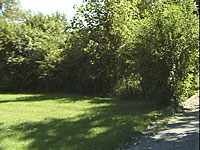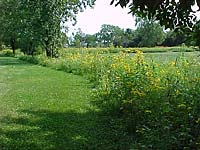

|
Streambank Erosion Control
Channelization, erosion and upstream development have altered the natural water flow within the stream corridor. Channelization has allowed water to move too swiftly through the stream and has resulted in streambank erosion. A consequence is loss of native plant vegetation along the streambanks and in the streambed. Upstream development has caused additional ecological changes to the stream corridor. In dry weather, water is held in upstream detention ponds. This water would normally filter into the stream corridor through natural processes as groundwater. In heavy storm events, water is released from the upstream detention ponds causing a flushing of water and contaminants, including sediments and nutrients, through the stream and into Harrier Marsh. This rapid flushing alters and degrades the wetland and wetland plant communities. |
Before

European buckthorn and other invasive brush obstruct the streambed and streambanks. The soil beneath the invasive brush is barren and eroded. The stream flows under the road where the curb can be seen at the lower right of the photograph. Click image for larger version and photo data Click for more "before" images. |
After

Following brush removal along the streambed and streambanks, native vegetation recolonizes the stream corridor, reducing erosion and opening views to Wolf Road Prairie. Click image for larger version and photo data Click for more "after" images. |
| Methods | Outcomes |